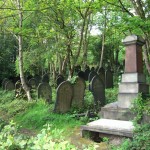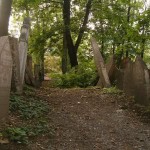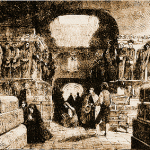Search results
What To Ask The Crypt Keeper – Genealogy Research at Graveyards
November 7, 2009 by Chris
Filed under Articles, Cemetery Searches, Genealogy Cemetery Searches, Genealogy Records 101
 Some people have asked me about gravestone photos. We received a couple of emails on that, so I thought it would be helpful to write a little about the role of graveyards in your genealogy research. They are critical! As you get your hands on death certificates or even learn more about where your ancestors lived, you’ll be able to consult the local graveyards to find information on spouses, birth dates, and other family members. Keep in mind that in many cases, families are buried together (sometimes for several generations). This was truer for our ancestors than it is for us today. People didn’t travel as they do today.
Some people have asked me about gravestone photos. We received a couple of emails on that, so I thought it would be helpful to write a little about the role of graveyards in your genealogy research. They are critical! As you get your hands on death certificates or even learn more about where your ancestors lived, you’ll be able to consult the local graveyards to find information on spouses, birth dates, and other family members. Keep in mind that in many cases, families are buried together (sometimes for several generations). This was truer for our ancestors than it is for us today. People didn’t travel as they do today.
Our past generations tended to live in the same area. This makes graveyards a great resource. Also remember that many graveyards are denomination specific. Don’t waste time looking for a Catholic ancestor in a Protestant graveyard.
Genealogy Trees | The Role of Cemeteries
December 31, 2008 by Chris
Filed under Articles, Cemetery Searches, Genealogy Cemetery Searches, Genealogy Records 101
 As regular readers of this site you know I’m a big fan of making sure cemetery research is a method used for researching your genealogy and family trees. Below is an example from Southern Graves (see link below for original post) on how we can find our past generations using cemetery search methods.
As regular readers of this site you know I’m a big fan of making sure cemetery research is a method used for researching your genealogy and family trees. Below is an example from Southern Graves (see link below for original post) on how we can find our past generations using cemetery search methods.
The author of the original post writes…
Mrs. Eliza B. R. Mendenhall died almost 160 years ago on December 29, 1848. She was 67 years of age at the time of her death, so her birth year was about 1781. She, along with her infant grandson John Bruce Limehouse, was interred in St. Philip’s Church Cemetery; Charleston, South Carolina.
I love the wording on this stone. In case you cannot read it via the photo, here is a transcription:
This marble marks the spot where repose
the remains of
Mrs. Eliza B. R. Mendenhall,
Who closed her earthly career on the 29th December A.D. 1848,
aged 67 years.
By her side sleeps her infant
grandson
John Bruce Limehouse.
“Thou art gone to the grave, but we will
not deplore thee
whose God was thy ransom, they Guardian
and Guide.
He gave thee, He took thee
and He will restore thee,
and death has no sting for the
Savior hath died.”
This stone is consecrated
to a beloved mother
by her daughter.
(This posting is from Southern Graves. Click the link to view the full article from its original source.)
As you can see from the transcription, there is a wealth of information to help us complete our family trees. Grave stones typically contain extensive records of birth and death dates. They also often cite family members.
By doing the math on age and date of death you can get the date of birth. While not cited here, you sometimes can discover where someone lived from a grave stone as well, which can lead to a local government office and a copy of a birth certificate (which, as you know, will reveal the parents and thus the next generation.)
Don’t overlook cemeteries in our work to build out your genealogy trees. They will save you a ton of time.
…
Where to Next?
Blank Family Tree with Step-by-Step Instructions
…
St. Andrew’s Cemetery; Darien, Georgia
September 17, 2008 by Chris
Filed under Articles, Cemetery Searches, Genealogy Cemetery Searches, Genealogy Records 101
 The poetic inscription at the beginning of this article about St. Andrew’s Church Cemetery in Darien, McIntosh County, Georgia, reads:
The poetic inscription at the beginning of this article about St. Andrew’s Church Cemetery in Darien, McIntosh County, Georgia, reads:
“At the end of this avenue, on high land overlooking the creeks and marshes, Thomas Spalding of Sapelo established his family burial ground.”
This short article is part of the Historical Marker Database recently uploaded from Southern Graves, a website dedicated to the history, research and preservation of Southern U.S. cemeteries and burial sites large and small.
The site contains Southern cemetery listings, directories, and a broad and wondrous selection of articles; from the humorous to the heartfelt and beyond. The site also contains a link to a remarkable must read Blog filled with winning and always interesting subject matter.
This site is not only a treasure to genealogists but should be commended for the spirit in which it is presented, respectful, yet full of the human experience.
A must read for all! Beautifully done!
I highly recommend a visit to Southern Graves Home.
…
Where to Next?
…
Cemetery for Cubs Fans
 You read that correctly, yes, a cemetery for Cubs Fans. That is the latest news from Southern Graves. It seems however that everyone is a-buzz with this news. In an article from the Chicago Tribune:
You read that correctly, yes, a cemetery for Cubs Fans. That is the latest news from Southern Graves. It seems however that everyone is a-buzz with this news. In an article from the Chicago Tribune:
“Cubs fans hoping for a World Series title before they die at least can be buried in a place that looks like Wrigley Field when they do.”
Beny Lipsman for the Chicagoist writes in his article “Pushing Ivy?”
“Marriage may be til death do us part, but apparently allegiances to one’s baseball team last even longer.”
Filed under Odd News the article titled “Cemetery gives Cubs fans burial site” from United Press International covers the story by saying, “Ground was broken Friday for a burial site at a Chicago cemetery modeled after a portion of landmark Wrigley Field to accommodate die-hard Chicago Cubs fans.” This could definitely make for some interesting genealogy research in years to come.
To read the full article visit Southern Graves
…
Where to Next?
…
Searching Cemeteries – Genealogy Tip
September 7, 2008 by Chris
Filed under Articles, Cemetery Searches, Genealogy Cemetery Searches, Genealogy Records 101
 Here is a s quick genealogy tip for searching cemeteries. Sometimes the obvious isn’t all that apparent. Remember that in past centuries, almost all people were buried according to ethnic origin or religious affiliation.
Here is a s quick genealogy tip for searching cemeteries. Sometimes the obvious isn’t all that apparent. Remember that in past centuries, almost all people were buried according to ethnic origin or religious affiliation.
So, the tip is: don’t waste your time looking in a Presbyterian cemetery for a Catholic ancestor. Sounds obvious now that I’ve said it, but it is such an easy (and frustrating) mistake to make.
Take care.
…
Where to Next?
…
Searching Cemetery Monument Foundations
February 9, 2008 by Chris
Filed under Articles, Cemetery Searches, Genealogy Cemetery Searches, Genealogy Records 101
 This book will intrigue anyone involved in serious genealogical research, posing a whole new way to uncover family roots and facts through research into cemeteries and their contents. This book has all kinds of great information from funeral art to conducting cemetery surveys. The author, Sharon Debartolo Carmack, covers how to access and interpret death certificates, obituaries, coroner’s records, wills, memorial and prayer cards, funeral home records, and mortality schedules. She also outlines the process of locating individual graves and elusive cemteries.
This book will intrigue anyone involved in serious genealogical research, posing a whole new way to uncover family roots and facts through research into cemeteries and their contents. This book has all kinds of great information from funeral art to conducting cemetery surveys. The author, Sharon Debartolo Carmack, covers how to access and interpret death certificates, obituaries, coroner’s records, wills, memorial and prayer cards, funeral home records, and mortality schedules. She also outlines the process of locating individual graves and elusive cemteries.
You can read more about this guide on Amazon.com:
Your Guide to Cemetery Research
…
Where to Next?
…
